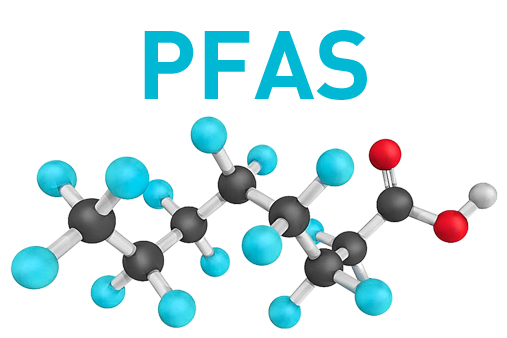PFAS (Per- and polyfluoroalkyl substances) are a class of synthetic organic chemicals that were created starting back in the 1940’s. They contain an alkyl group where all or most of the hydrogen atoms have been replaced with fluorine. PFAS chemicals are currently found in a number of commercial and consumer products including firefighting foam (AFFF), clothing and textiles, non-stick cookware, food packaging and personal care products among others.
The chemical properties that make them so useful (strongly chemical, and UV resistance) makes them essentially non-biodegradable and difficult to destroy. As such, they tend to bioaccumulate and have been found in human and animal tissues worldwide. They have also been found in ground and surfaces waters in numerous locations.
Recently their presence in consumer products and the environment has raised concerns in the environmental community as well numerous governmental agencies and the US Congress. In 2020, the USEPA was directed to add 172 PFAS chemicals to annual TRI reporting list by the NDAA. In 2021, three additional PFAS were added to the TRI list bringing the total to 175 specific compounds subject to reporting.
Additionally, the USEPA is proposing reporting and recordkeeping requirements for PFAS under TSCA Section 8(a)(7). The EPA is proposing that all persons that manufactured or imported PFAS in any year since 2011 electronically report information regarding PFAS uses, production volumes, disposal, exposures and hazards. The comment period for this proposed regulation closes on September 27, 2021
On July 21, 2021, the US House of Representatives passed the “PFAS Action Act of 2021” (H.B. 2467). It is currently under review by the US Senate Committee on the Environment and Public Works.
The PFAS Action Act, if passed would require the USEPA to:
- Designate PFOA and PFOS (Perfluorooctanoic acid and perfluorooctanesulfonic acid) as hazardous substances under CERCLA and, within 5 years, determine if other PFAS should be designated as hazardous substances.
- Establish if PFAS should be designated as toxic pollutants under the CWA.
- Issue a ruling adding PFOA and PFOS to the list of hazardous air pollutants under the CAA
- Test all PFAS for toxicity to human health
- Regulate the disposal of PFAS containing materials
Currently 21 states, concerned by the Federal government’s inaction on PFAS, have enacted or are considering enacting bans on PFAS in certain consumer products. The products include:
- AFFF firefighting foam
- Children’s products
- Food packaging
- Personal care products
- Personal Protective Equipment (PPE)
- Pet products
The high level of interest and scrutiny surrounding PFAS chemicals has prompted many solid waste and hazardous waste disposal companies to act on their own. A number of non-hazardous waste (Subtitle D) landfills as well as Waste-to-Energy (W-T-E) facilities have stopped receiving any wastes that contain PFAS. Additionally, a few cement kilns that burn hazardous waste as supplemental fuel are no longer receiving PFAS containing waste outright or are greatly limiting the amount of PFAS in wastes they process. While most of the hazardous waste incinerators are still accepting PFAS containing wastes, it is expected that some of them will either stop accepting them at some point or will reduce the amounts they are willing to process.

